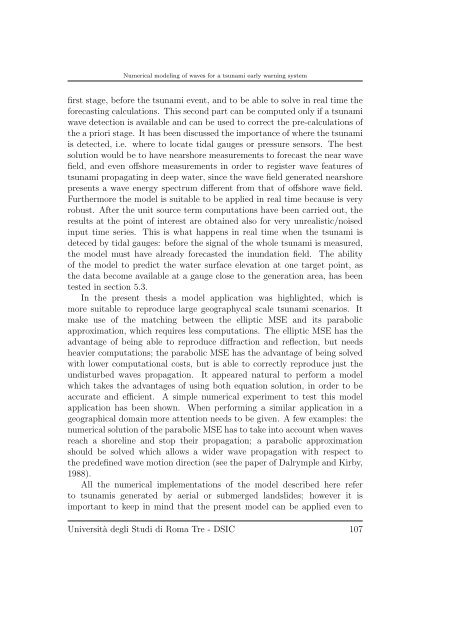Numerical modeling of waves for a tsunami early warning system
Numerical modeling of waves for a tsunami early warning system
Numerical modeling of waves for a tsunami early warning system
Create successful ePaper yourself
Turn your PDF publications into a flip-book with our unique Google optimized e-Paper software.
<strong>Numerical</strong> <strong>modeling</strong> <strong>of</strong> <strong>waves</strong> <strong>for</strong> a <strong>tsunami</strong> <strong>early</strong> <strong>warning</strong> <strong>system</strong><br />
first stage, be<strong>for</strong>e the <strong>tsunami</strong> event, and to be able to solve in real time the<br />
<strong>for</strong>ecasting calculations. This second part can be computed only if a <strong>tsunami</strong><br />
wave detection is available and can be used to correct the pre-calculations <strong>of</strong><br />
the a priori stage. It has been discussed the importance <strong>of</strong> where the <strong>tsunami</strong><br />
is detected, i.e. where to locate tidal gauges or pressure sensors. The best<br />
solution would be to have nearshore measurements to <strong>for</strong>ecast the near wave<br />
field, and even <strong>of</strong>fshore measurements in order to register wave features <strong>of</strong><br />
<strong>tsunami</strong> propagating in deep water, since the wave field generated nearshore<br />
presents a wave energy spectrum different from that <strong>of</strong> <strong>of</strong>fshore wave field.<br />
Furthermore the model is suitable to be applied in real time because is very<br />
robust. After the unit source term computations have been carried out, the<br />
results at the point <strong>of</strong> interest are obtained also <strong>for</strong> very unrealistic/noised<br />
input time series. This is what happens in real time when the <strong>tsunami</strong> is<br />
deteced by tidal gauges: be<strong>for</strong>e the signal <strong>of</strong> the whole <strong>tsunami</strong> is measured,<br />
the model must have already <strong>for</strong>ecasted the inundation field. The ability<br />
<strong>of</strong> the model to predict the water surface elevation at one target point, as<br />
the data become available at a gauge close to the generation area, has been<br />
tested in section 5.3.<br />
In the present thesis a model application was highlighted, which is<br />
more suitable to reproduce large geographycal scale <strong>tsunami</strong> scenarios. It<br />
make use <strong>of</strong> the matching between the elliptic MSE and its parabolic<br />
approximation, which requires less computations. The elliptic MSE has the<br />
advantage <strong>of</strong> being able to reproduce diffraction and reflection, but needs<br />
heavier computations; the parabolic MSE has the advantage <strong>of</strong> being solved<br />
with lower computational costs, but is able to correctly reproduce just the<br />
undisturbed <strong>waves</strong> propagation. It appeared natural to per<strong>for</strong>m a model<br />
which takes the advantages <strong>of</strong> using both equation solution, in order to be<br />
accurate and efficient. A simple numerical experiment to test this model<br />
application has been shown. When per<strong>for</strong>ming a similar application in a<br />
geographical domain more attention needs to be given. A few examples: the<br />
numerical solution <strong>of</strong> the parabolic MSE has to take into account when <strong>waves</strong><br />
reach a shoreline and stop their propagation; a parabolic approximation<br />
should be solved which allows a wider wave propagation with respect to<br />
the predefined wave motion direction (see the paper <strong>of</strong> Dalrymple and Kirby,<br />
1988).<br />
All the numerical implementations <strong>of</strong> the model described here refer<br />
to <strong>tsunami</strong>s generated by aerial or submerged landslides; however it is<br />
important to keep in mind that the present model can be applied even to<br />
Università degli Studi di Roma Tre - DSIC 107

















